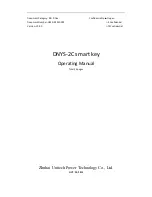
BLACOH Fluid Control
2
SAFETY Warnings
Dampeners should only be installed, operated and repaired by experienced and trained professional mechanics. Read and
observe all instructions and safety warnings in this Manual before installing, operating or repairing dampeners.
Safety Symbols
The following symbols indicate cautions, warnings and notes that must be observed for safe and satisfactory installation,
operation and maintenance of dampener.
WARNINGS
Danger of serious injury or death could occur if these warnings are ignored.
CAUTIONS
Equipment damage, injury or death could occur if these cautions are not observed.
NOTES
Special instructions for safe and satisfactory installation, operation and maintenance.
General Safety
CAUTION!
Observe all safety symbols in installation and
operation instructions.
The internal dampener pressure will equal the
maximum fluid pressure of the system in which it is
installed.
DO NOT
exceed maximum allowable working
pressure (MAWP) specified on dampener serial tag
or marked on dampener. If serial tag is missing,
DO
NOT
use dampener without consulting distributor or
factory for maximum pressure rating.
Always make sure safety shutoff valves, regulators,
pressure relief valves, gauges, etc. are working
properly before starting system or assembly.
Verify dampener model received against purchase
order and shipper.
Before starting a system or assembly make certain
the discharge point of the piping system is clear and
safe, and all persons have been warned to stand
clear.
DO NOT
put your face or body near dampener
when the system or assembly is operating or
dampener is pressurized.
DO NOT
operate a dampener that is leaking,
damaged, corroded or otherwise unable to contain
internal fluid, air or gas pressure.
DO NOT
pump incompatible fluids through
dampener. Consult distributor or factory if you are
not sure of the compatibility of system fluids with
dampener materials.
Dampeners are designed to operate with
compressed air or clean dry Nitrogen
only
. Other
compressed gases have not been tested and may
be unsafe to use.
DO NOT USE OXYGEN.
Always shut off air supply, remove internal
dampener pressure and shut dampener isolation
valve before performing dampener maintenance or
repair.
Remove all pressure from dampener AND pumping
system before disassembly, removal or
maintenance.
Static spark can cause an explosion resulting in
severe injury or death. Ground dampeners and
pumping system when pumping flammable
fluids or operating in flammable environments.
NOTE: EC standard EN-13463-1 and EN-13463-5
(ATEX) require grounding (earthing) on
dampeners when the potential for static
sparking is present. A grounding point is
located and marked on ATEX specific dampener
models.
Summary of Contents for SENTRY CIP
Page 10: ...9 BLACOH Fluid Control NOTES ...






























